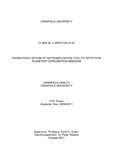JavaScript is disabled for your browser. Some features of this site may not work without it.
| dc.contributor.advisor | Cullen, David C. | |
| dc.contributor.advisor | Roberts, Peter | |
| dc.contributor.author | Juanes-Vallejo, Clara M. | |
| dc.date.accessioned | 2012-06-29T14:22:36Z | |
| dc.date.available | 2012-06-29T14:22:36Z | |
| dc.date.issued | 2011-10 | |
| dc.identifier.uri | http://dspace.lib.cranfield.ac.uk/handle/1826/7319 | |
| dc.description.abstract | The aim of the research documented in this thesis was to explore issues associated with the development of instrumentation for life detection and characterisation in a planetary exploration context. Within this aim, the following objectives had to be achieved: 1. To consider current and near-future single molecule detection (ultra-low lower limit of detection) analytical techniques that would be compatible with development into a Space qualifiable in situ analytical instrument for the detection of biomarkers in a planetary exploration context. 2. To practically consider the consequences of Planetary Protection and Contamination Control on the development of a sample return instrumentation in a planetary exploration context. 3. To consider the implications of flying an in situ instrument on-board a stratospheric balloon platform in order to apply them into a specific planetary exploration mission: In order to achieve the objectives described above, the following work was pursued: A desk-based European Space Agency (ESA) study was carried out which entailed producing a literature review on single molecule detection technologies that had to be validated by the expert community. This was done by organising an International Workshop on Single Molecule Detection Technologies for Space Applications in March 2009 at Cranfield University, UK. The approved technologies then had to be analysed with standard analytical techniques (i.e., tradeoffs) in order to propose a specific technology for development and present its breadboard implementation and test plans at the end of the study. A sample return experiment implementing PP&CC constraints and protocols was designed, built, tested and flown on-board the ESA, Swedish Space Corporation (SSC), Swedish National Space Board (SNSB) and German Space Agency (DLR) BEXUS stratospheric balloon platform. The biological and engineering results obtained from the sample return flight were then analysed and lessons learnt obtained for future flights. Another desk-based study was performed to research future stratospheric balloon platforms for the exploration of Venus’ cloud layer. The in situ instrument previously proposed for the detection of biomarkers for planetary exploration missions was then put forward as a possible payload for a Venusian stratospheric balloon platform and approved by experts during the Venus Exploration Analysis Group (VEXAG) conference held in August 2011 in Washington D.C, USA. The first part of the research involved studying ultra-low lower limit of detection technologies as these have the potential to impact significantly on the technological and scientific requirements of future Space missions. Two systems were proposed: one based on Tandem Mass Spectrometry (with Cylindrical Ion Trap analysers) followed by Surface Enhanced Raman Scattering spectroscopy to create an MS/MS-SERS instrument for the detection of astrobiology biomarkers in Martian regolith, Europan ice and samples from Titan’s hydrocarbon lakes; and a second one as a Stand-Alone SERS system for the detection of biomarkers in Enceladean plumes, Venusian clouds and cometary coma. The second part of the research practically explored the design of instrumentation for stratospheric balloon platforms. CASS•E, the Cranfield Astrobiological Stratospheric Sampling Experiment, was a life detection experiment that aimed to be capable of detecting stratospheric microorganisms. The experiment consisted of a pump which drew air from the Stratosphere through a 0.2 μm collection filter which retained any microorganisms and >0.2 μm particulates present in the pumped air. Due to the expected rarity of microbes in the Stratosphere compared to the known levels of contamination at ground level, Planetary Protection and Contamination Control (PP&CC)constraints were introduced. Therefore PP&CC protocols were followed to implement Space qualified cleaning and sterilisation techniques; biobarrier technology was implemented to prevent re-contamination of the instrument after sterilisation; and cleanliness and contamination was monitored throughout assembly, integration and testing. The third part of the research demonstrated how an instrument from the first part of the study could be proposed as a payload on-board a stratospheric balloon platform with a focused mission context, i.e., a life detection mission for Venus. Therefore, the research concluded with the proposal of a payload for a Venus mission based on SERS technology on-board a stratospheric balloon platform to search for life above or in the mid Venusian cloud cover. | en_UK |
| dc.language.iso | en | en_UK |
| dc.publisher | Cranfield University | en_UK |
| dc.rights | © Cranfield University 2011. All rights reserved. No part of this publication may be reproduced without the written permission of the copyright owner. | en_UK |
| dc.subject | Astrobiology | en_UK |
| dc.subject | Tandem Mass Spectroscopy | en_UK |
| dc.subject | SERS | en_UK |
| dc.subject | Stratospheric balloons | en_UK |
| dc.subject | PP&CC | en_UK |
| dc.subject | Venus | en_UK |
| dc.title | Engineering design instrumentation for life detection planetary exploration missions | en_UK |
| dc.type | Thesis or dissertation | en_UK |
| dc.type.qualificationlevel | Doctoral | en_UK |
| dc.type.qualificationname | PhD | en_UK |
